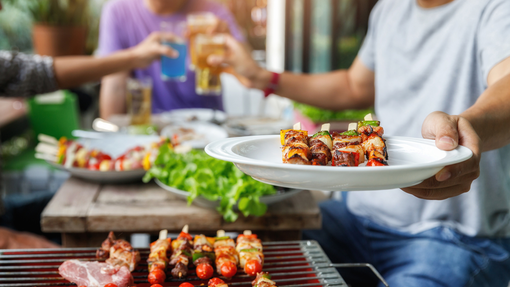
Meal planning for one
There are definite advantages to cooking for one – the main one being not having to cater to someone else’s dietary requirements or preferences!
But, it has its downsides as well. You’d think that cooking for just yourself would be cheaper than cooking for two or more, but that’s not always the case! Yes, the quantity of food you need for each meal is less, but food is often sold in quantities needed for larger numbers of people, meaning you still have to spend the same to buy ingredients. It’s also harder to use it all up before it goes off. In this post, we’ll look at how you can eat a varied and nutritious diet that saves food and effort when you’re cooking for one.
Plan the week’s meals ahead
Meal planning is just as important when you’re cooking for one as it is if you have lots of hungry mouths to feed. The best way to save both money and food is to plan your meals in advance, basing your meal plan on what you already have in your fridge, freezer and cupboards. Don’t forget to factor in lunchtimes, too, as you can make the most of dinner leftovers to replace those expensive shop-bought sandwiches. More on that shortly! By the way, you don’t need to plan meals for every single day of the week – allow a couple of nights off for a meal out, a takeaway or something from the freezer. It’ll make a big difference even doing a five-day meal plan.
Make a shopping list
From your meal plan, you can then make a shopping list of any extra ingredients you need. This will stop you buying too much – or not enough – so that you end up with only what you’ll definitely use. Buying loose fruit and veg is a great way to ensure you don’t end up with too much fresh produce that you’ll struggle to get through.
Cutting recipes down to size
Why is it that recipes always seem to serve two or four people – never just one? It’s the same with recipe boxes that deliver all the ingredients you need for your chosen recipes; the minimum number of people often seems to be two. To make single servings, you can use our portion planner or simply divide the quantities of ingredients in half or into quarters. They will often still take about the same amount of time to cook, but keep checking and set any timers a few minutes earlier than recommended in the recipe in case it’s cooked quicker than the bigger quantity would have done.
The beauty of batch cooking
The alternative to trimming down recipes is to make the number of portions it’s designed for and make the most of the leftovers. Making dishes in bulk gives you maximum results for the effort you put in, and it’s far more time-efficient and cost-effective than making every meal single-serving. It’s also a great way to use up the whole of every ingredient, rather than leaving behind half a broccoli or a third of a carton of cream, which will be harder to use up. As we talked about in our article on lunchbox leftovers, it makes a lot of sense to make enough food for two or more people and then save the second portion for lunch. You can also scale up this idea and make enough extra portions for several future meals. Dishes that work well for batch cooking include:
- Pasta dishes - from spaghetti bolognese to creamy carbonara, it’s dead easy to increase the quantity of pasta you cook without any additional effort. Alternatively (especially if space is tight in your freezer), you can make big batches of the pasta sauce and freeze that in portions ready to reheat when you next feel like a pasta dinner.
- Lasagne - making a lasagne entails a fair bit of effort, but make a nice big dish of it and you can divide it into portions for easy future dinners.
- Cottage or shepherd’s pie - these also freeze well cut into portions.
- Chilli con carne or vegetarian chilli - make a big batch and freeze in portions that you can reheat and serve with rice or a jacket potato.
- Curry - ditto!
- Pulled pork - pop a cheap shoulder of pork into the slow cooker (or cook on low over a few hours in the oven) and transform it into barbecue pulled pork. You can freeze it in individual portions and enjoy it in a bun with salad or on a jacket potato.
- Chicken or veggie fajitas - don’t let the ‘serves 4 people’ fajita kits put you off – make the whole lot and wrap up any that you don’t eat in foil ready for easy lunches. They’ll freeze happily - sour cream, cheese, guacamole and all!
- Soup - the perfect way to use up leftover veg, soup is perfect for batch cooking and you can freeze it in well-sealed reusable containers.
- Risotto - think you can’t freeze rice? Think again! Risotto freezes really well and, like soup, is also a great way to use up whatever veg you have in the fridge. You can also make leftover risotto into delicious arancini balls. Read our guide on how to safely freeze and defrost rice.
Of course, you can also bulk out smaller quantities of leftovers with extra ingredients the second day, such as serving leftover roast chicken with a jacket potato and salad.
Making the most of the freezer
As you’ll have gathered by now, you don’t have to eat the same thing night after night to use up a big batch of cooking straightaway. Your freezer is worth its weight in gold when it comes to freezing second, third or even fourth portions of food for another day. This gives you a freezer full of homemade ‘ready meals’. Not only is this a great way to save food and money, but it’s also lovely for those busy days where you don’t feel like cooking.
The easiest way to freeze food is in any reusable resealable container – which can be washed and reused time and again. Before popping your leftovers in the freezer, write on the lid what’s inside and when you made it, and use it within three months. Defrost it thoroughly and then microwave it when you’re ready to eat – make sure it’s piping hot before enjoying!
Store cupboard essentials
Whether cooking a one-off meal for yourself, using up leftover fresh foods, or batch-cooking – kitchen cupboard ingredients are your best friend! If you add on a tin of tomatoes, beans or lentils, stock cubes and a few key dried herbs and spices here and there to your food shops, you’ll soon be able to whip up casseroles, curries, soups and other creations. These items have a long shelf-life as well, so you’ll have lots of time to use them up.
Sharing the load
Cooking for yourself but living in a shared home? It might be worth talking to your housemates about food. Would they be up for sharing the cost of bulk-bought items (bags of rice or pasta perhaps), and maybe even rotating the cooking once in a while for a shared meal? You could all end up saving money on your food shop, but also enjoy a few more homemade, low-cost meals with minimal effort.
By following the tips we’ve shared today, you’ll soon find you can go whole weeks without having to lift a finger in the kitchen – and you’ll be saving so much food, too!
Check out our recipe bank for lots of tasty inspiration.




